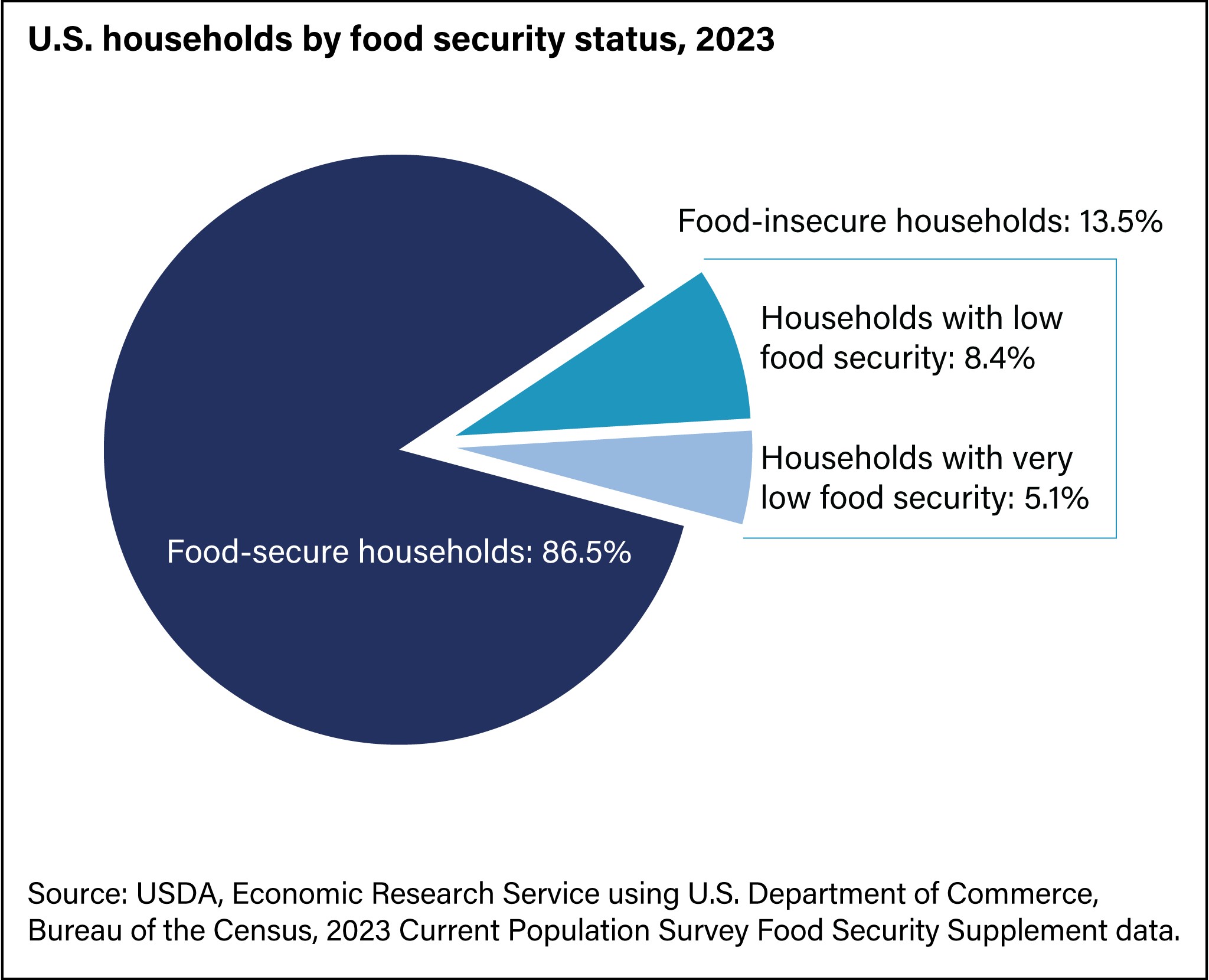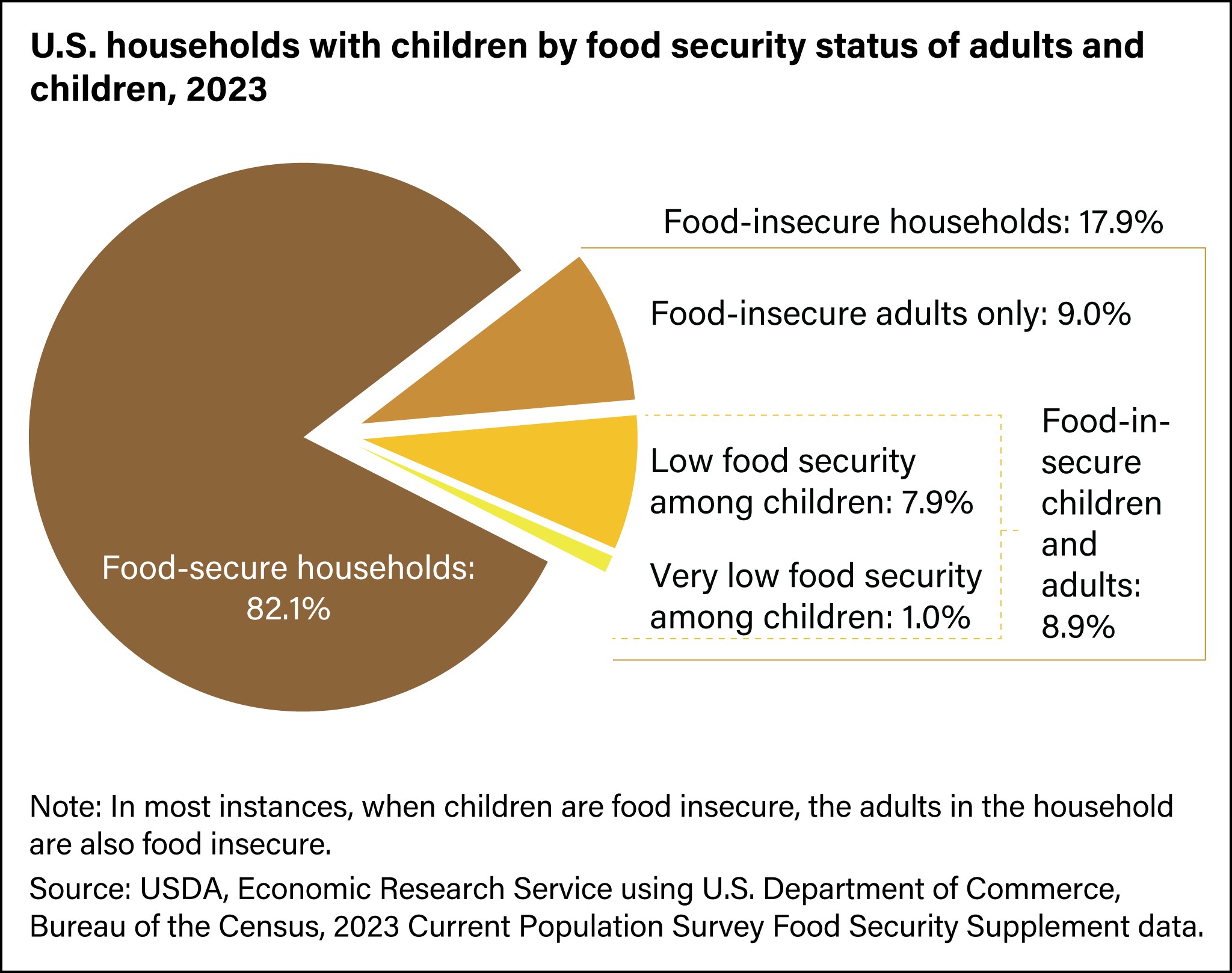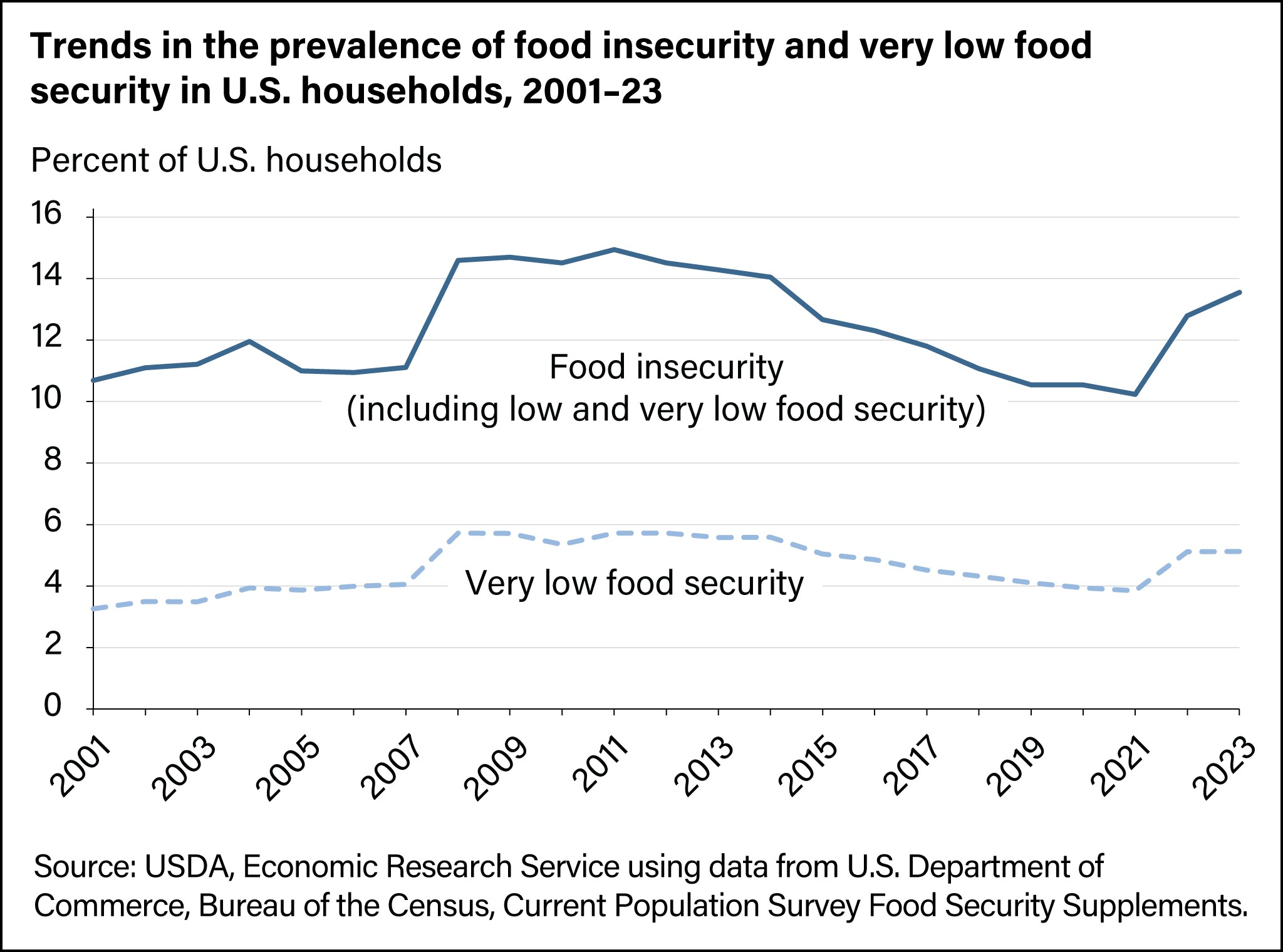How Many People Are Food Insecure? In 2023, 47.4 million individuals in the United States lived in food-insecure households, highlighting a critical issue that FOODS.EDU.VN is dedicated to addressing by offering resources and information to help understand and combat food insecurity. By delving into the depths of this subject, we provide insights into the causes, effects, and potential solutions to food insecurity, and we aim to empower individuals and communities to make a difference, fostering a more food-secure world by focusing on food availability, accessibility, and affordability.
1. Understanding Food Insecurity: A Deep Dive
What does it really mean when we say someone is food insecure? Food insecurity, at its core, refers to the state of being without reliable access to a sufficient quantity of affordable, nutritious food. It’s not just about hunger; it’s about the uncertainty and anxiety of not knowing where your next meal will come from.
1.1. Defining Food Insecurity
Food insecurity is defined as the limited or uncertain availability of nutritionally adequate and safe foods, or limited or uncertain ability to acquire acceptable foods in socially acceptable ways, according to the USDA (U.S. Department of Agriculture). This definition encompasses a range of experiences, from worrying about running out of food to actually skipping meals or reducing food intake due to lack of resources.
1.2. The Spectrum of Food Insecurity: Low vs. Very Low
Food insecurity isn’t a monolithic experience. It exists on a spectrum, with two primary classifications:
- Low Food Security: Households with low food security experience reductions in the variety and desirability of their diets, but their overall food intake and eating patterns are not substantially disrupted. They may rely on less expensive, less nutritious foods, or participate in federal food assistance programs to stretch their budgets.
- Very Low Food Security: Households with very low food security experience disruptions in their normal eating patterns and reduced food intake. This means that one or more household members may skip meals, reduce portion sizes, or experience hunger due to lack of resources. This level of food insecurity has serious consequences for health and well-being.
1.3. Measuring Food Insecurity: How the Numbers Are Gathered
The USDA uses a rigorous survey methodology to measure food insecurity in the United States. Each year, the Current Population Survey Food Security Supplement (CPS-FSS) collects data from a nationally representative sample of households. The survey includes a series of questions about households’ experiences with food access and affordability during the previous 12 months. These questions cover topics such as:
- Whether the household worried about running out of food.
- Whether they could afford to eat balanced meals.
- Whether they had to cut the size of meals or skip meals.
- Whether they ate less than they felt they should because of a lack of money.
- Whether any household members experienced hunger.
Responses to these questions are used to classify households as food secure, low food security, or very low food security. This data provides a comprehensive picture of the prevalence and severity of food insecurity in the United States.
2. The Staggering Statistics: How Many People Face Food Insecurity?
The numbers paint a stark picture of the reality of food insecurity. Millions of people struggle to put food on the table, and the problem is more widespread than many realize.
2.1. National Prevalence of Food Insecurity
According to the USDA’s latest report, in 2023:
- 13.5 percent of U.S. households were food insecure. This translates to 18 million households.
- Within that group, 8.4 percent (11.2 million households) had low food security.
- 5.1 percent (6.8 million households) experienced very low food security.
- 47.4 million people lived in food-insecure households.
These figures represent a statistically significant increase in food insecurity compared to 2022, highlighting the growing challenges faced by many Americans.
2.2. Food Insecurity Among Children
Children are particularly vulnerable to the effects of food insecurity. In 2023:
- 17.9 percent of households with children were food insecure, affecting 6.5 million households.
- In 8.9 percent of households with children (3.2 million households), both children and adults were food insecure.
- 841,000 children experienced very low food security, meaning they faced reduced food intake and disrupted eating patterns.
While children are often shielded from the most severe consequences of food insecurity, these numbers demonstrate that millions of children are still at risk of hunger and malnutrition.
2.3. Disparities in Food Insecurity: Who Is Most Affected?
Food insecurity does not affect all populations equally. Certain groups are disproportionately vulnerable due to systemic inequalities and economic challenges. Key disparities include:
- Households with Children: As mentioned above, households with children, particularly those with single parents, experience higher rates of food insecurity.
- Racial and Ethnic Minorities: Black and Hispanic households are significantly more likely to be food insecure than white households. This disparity is rooted in historical and ongoing discrimination in areas such as employment, housing, and education.
- Low-Income Households: Poverty is a major driver of food insecurity. Households with incomes below the poverty line are at the greatest risk of hunger and malnutrition.
- Rural Communities: Residents of rural areas often face unique challenges in accessing affordable, nutritious food, including limited transportation options and fewer grocery stores.
2.4. State-Level Variations in Food Insecurity
Food insecurity rates also vary significantly from state to state. According to data averaged over the 2021-2023 period:
- States with the highest rates of food insecurity include Arkansas, Mississippi, and Louisiana.
- States with the lowest rates of food insecurity include New Hampshire, Massachusetts, and North Dakota.
These variations reflect differences in economic conditions, social safety net programs, and access to resources across states.
3. The Root Causes: What Drives Food Insecurity?
Understanding the underlying causes of food insecurity is essential for developing effective solutions. Food insecurity is a complex issue with multiple contributing factors.
3.1. Poverty and Income Inequality
Poverty is arguably the most significant driver of food insecurity. When families lack sufficient income to meet their basic needs, food often becomes a casualty. The rise of income inequality in recent decades has exacerbated this problem, with a growing gap between the rich and the poor.
3.2. Unemployment and Job Instability
Job loss or unstable employment can quickly plunge families into food insecurity. Many low-wage jobs offer limited benefits and unpredictable hours, making it difficult for workers to budget and plan for their food needs.
3.3. Lack of Access to Affordable Housing
High housing costs can strain household budgets, leaving less money for food. In many cities, rents and home prices have skyrocketed, forcing families to make difficult choices between housing and food.
3.4. Health Issues and Medical Expenses
Chronic illnesses and disabilities can limit individuals’ ability to work and earn income. Medical expenses can also eat into household budgets, leaving less money for food. The high cost of healthcare in the United States is a major contributor to food insecurity.
3.5. Limited Access to Nutritious Food
In many communities, particularly low-income and rural areas, access to affordable, nutritious food is limited. These “food deserts” lack full-service grocery stores and offer few options beyond fast food and convenience stores.
3.6. Systemic Discrimination and Inequality
As mentioned earlier, racial and ethnic minorities face higher rates of food insecurity due to systemic discrimination in employment, housing, education, and other areas. These inequalities create barriers to economic opportunity and contribute to food insecurity.
4. The Consequences: What Are the Impacts of Food Insecurity?
Food insecurity has far-reaching consequences for individuals, families, and communities. It affects physical and mental health, academic achievement, and economic productivity.
4.1. Health Impacts of Food Insecurity
Food insecurity is linked to a wide range of health problems, including:
- Malnutrition: Inadequate intake of essential nutrients can lead to malnutrition, which can impair growth and development in children and weaken the immune system in adults.
- Chronic Diseases: Food insecurity is associated with a higher risk of chronic diseases such as diabetes, heart disease, and obesity. This may be due to reliance on less nutritious, processed foods.
- Mental Health Issues: Food insecurity can cause stress, anxiety, and depression. The constant worry about food can take a toll on mental well-being.
- Increased Healthcare Costs: The health problems associated with food insecurity can lead to higher healthcare costs for individuals and the healthcare system as a whole.
4.2. Impact on Children’s Development and Education
Food insecurity can have a particularly devastating impact on children:
- Impaired Cognitive Development: Malnutrition can impair brain development, leading to learning disabilities and reduced academic achievement.
- Behavioral Problems: Food-insecure children are more likely to experience behavioral problems such as aggression, hyperactivity, and difficulty concentrating.
- Poor School Performance: Hunger and lack of nutrition can make it difficult for children to focus in school and succeed academically.
- Long-Term Economic Consequences: The educational deficits associated with food insecurity can limit children’s future economic opportunities, perpetuating the cycle of poverty.
4.3. Economic Impacts of Food Insecurity
Food insecurity also has economic consequences for communities and the nation as a whole:
- Reduced Workforce Productivity: Malnutrition and health problems can reduce workforce productivity, leading to lower earnings and slower economic growth.
- Increased Healthcare Costs: As mentioned earlier, food insecurity is associated with higher healthcare costs.
- Strain on Social Safety Net Programs: High rates of food insecurity can strain social safety net programs such as SNAP (Supplemental Nutrition Assistance Program) and WIC (Women, Infants, and Children), requiring increased funding.
- Community Instability: Food insecurity can contribute to community instability, leading to increased crime rates and social unrest.
5. Solutions: What Can Be Done to Combat Food Insecurity?
Addressing food insecurity requires a multi-pronged approach that tackles both the symptoms and the root causes of the problem.
5.1. Strengthening Federal Nutrition Programs
Federal nutrition programs such as SNAP, WIC, and the National School Lunch Program are crucial for combating food insecurity. These programs provide a safety net for millions of low-income families and individuals. Strengthening these programs by increasing funding, expanding eligibility, and improving access is essential.
5.2. Increasing Employment Opportunities and Wages
Creating more jobs and raising wages are key to reducing poverty and food insecurity. Policies such as raising the minimum wage, expanding access to job training, and supporting small businesses can help boost economic opportunities for low-income workers.
5.3. Expanding Access to Affordable Housing
Addressing the housing crisis is crucial for reducing food insecurity. Policies such as increasing the supply of affordable housing, providing rental assistance, and preventing evictions can help families stay housed and have more money for food.
5.4. Improving Access to Healthcare
Expanding access to affordable healthcare is essential for preventing health problems that can lead to food insecurity. Policies such as expanding Medicaid, increasing access to preventive care, and lowering prescription drug costs can help families stay healthy and have more money for food.
5.5. Supporting Local Food Initiatives
Community-based food initiatives such as food banks, food pantries, community gardens, and farmers markets play a vital role in addressing food insecurity at the local level. Supporting these initiatives through funding, volunteer work, and donations can help increase access to nutritious food for those in need.
5.6. Addressing Systemic Inequalities
Addressing systemic inequalities is essential for creating a more equitable and food-secure society. Policies such as promoting racial and ethnic equity in employment, housing, and education can help break down barriers to economic opportunity and reduce disparities in food insecurity.
6. The Role of FOODS.EDU.VN in Combating Food Insecurity
FOODS.EDU.VN is committed to playing a role in combating food insecurity by providing information, resources, and inspiration to individuals and communities.
6.1. Providing Information and Education
FOODS.EDU.VN offers a wealth of information on topics related to food, nutrition, and food security. We provide articles, recipes, and resources that can help individuals and families make informed choices about their food and health.
6.2. Sharing Recipes and Cooking Tips
FOODS.EDU.VN features a wide range of recipes that are both delicious and affordable. We also provide cooking tips and techniques that can help people save money and reduce food waste.
6.3. Promoting Food Literacy
FOODS.EDU.VN is committed to promoting food literacy, which is the ability to understand and apply information about food and nutrition. We believe that food literacy is essential for making healthy food choices and preventing food insecurity.
6.4. Connecting People with Resources
FOODS.EDU.VN provides links to a variety of resources that can help people find food assistance, job training, and other support services. We aim to connect people with the resources they need to improve their food security.
7. Success Stories: Making a Difference in the Fight Against Hunger
Despite the challenges, there are countless inspiring stories of individuals, organizations, and communities making a difference in the fight against hunger.
7.1. Examples of Effective Programs and Initiatives
- Food Banks and Food Pantries: Organizations like Feeding America and local food banks provide emergency food assistance to millions of people each year.
- Community Gardens: Community gardens provide access to fresh, nutritious produce and promote community engagement.
- School Meal Programs: Programs like the National School Lunch Program and the School Breakfast Program ensure that children have access to nutritious meals at school.
- SNAP Outreach Programs: SNAP outreach programs help eligible individuals and families enroll in SNAP, providing them with food assistance benefits.
7.2. Personal Stories of Overcoming Food Insecurity
There are countless personal stories of individuals who have overcome food insecurity with the help of these programs and initiatives. These stories demonstrate the resilience of the human spirit and the power of community support.
7.3. Highlighting Individuals and Organizations Making an Impact
FOODS.EDU.VN is committed to highlighting the work of individuals and organizations making a positive impact in the fight against hunger. We believe that sharing these stories can inspire others to get involved and make a difference.
8. Taking Action: How You Can Help
Combating food insecurity is a collective responsibility. There are many ways that you can get involved and make a difference in your community.
8.1. Volunteer Opportunities
- Volunteer at a Food Bank or Food Pantry: Food banks and food pantries rely on volunteers to sort and distribute food.
- Help with a Community Garden: Community gardens need volunteers to plant, weed, and harvest produce.
- Serve Meals at a Soup Kitchen: Soup kitchens provide hot meals to people in need and rely on volunteers to prepare and serve the food.
8.2. Donation Opportunities
- Donate to a Food Bank or Food Pantry: Food banks and food pantries accept donations of non-perishable food items and monetary contributions.
- Support a Community Garden: Community gardens need donations of seeds, tools, and other supplies.
- Give to Organizations Fighting Hunger: Many organizations are working to combat hunger at the local, national, and global levels.
8.3. Advocacy and Awareness
- Contact Your Elected Officials: Urge your elected officials to support policies that address food insecurity, such as increasing funding for SNAP and WIC.
- Raise Awareness About Food Insecurity: Share information about food insecurity with your friends, family, and social media networks.
- Educate Yourself About the Issue: Learn more about the causes and consequences of food insecurity and what you can do to help.
9. Debunking Myths: Separating Fact from Fiction About Food Insecurity
There are many misconceptions about food insecurity that can hinder efforts to address the problem. It’s important to debunk these myths and promote accurate information.
9.1. Common Misconceptions About Who Experiences Food Insecurity
- Myth: Food insecurity only affects homeless people.
- Fact: Food insecurity affects people from all walks of life, including working families, seniors, and students.
- Myth: People who are food insecure are lazy or irresponsible.
- Fact: Food insecurity is often the result of circumstances beyond an individual’s control, such as job loss, illness, or high housing costs.
9.2. Addressing Stigma and Promoting Empathy
It’s important to address the stigma associated with food insecurity and promote empathy for those who are struggling. Food insecurity is not a personal failing, and people should not be ashamed to seek help.
9.3. Emphasizing the Complexity of the Issue
Food insecurity is a complex issue with multiple contributing factors. There is no single solution, and it requires a multi-pronged approach to address the problem effectively.
10. The Future of Food Security: Challenges and Opportunities
The fight against food insecurity is an ongoing challenge. However, there are also opportunities to make progress and create a more food-secure future.
10.1. Emerging Challenges to Food Security
- Climate Change: Climate change is disrupting food production and increasing food prices, making it more difficult for people to access affordable food.
- Economic Instability: Economic downturns and job losses can quickly increase rates of food insecurity.
- Global Conflicts: Global conflicts can disrupt food supply chains and lead to food shortages in certain regions.
10.2. Promising Innovations and Solutions
- Sustainable Agriculture: Sustainable agriculture practices can help increase food production while protecting the environment.
- Food Technology: Food technology can help improve food storage, processing, and distribution, reducing food waste and increasing access to nutritious food.
- Community-Led Initiatives: Community-led initiatives can empower local communities to address food insecurity in their own ways.
10.3. Call to Action: Building a More Food-Secure World Together
Combating food insecurity requires a collective effort. By working together, we can create a more food-secure world for all.
Here are some updated statistics and trends related to food insecurity, presented in a table format:
| Category | 2022 | 2023 | Change | Source |
|---|---|---|---|---|
| Households Food Insecure | 12.8% | 13.5% | Statistically Higher | USDA, ERS (Household Food Security in the United States in 2023) |
| Households with Low Food Security | 7.7% | 8.4% | Statistically Higher | USDA, ERS |
| Households with Very Low Food Security | 5.1% | 5.1% | Unchanged | USDA, ERS |
| People in Food-Insecure Households | Not Specified | 47.4 million | Increase | USDA, ERS |
| Households with Children Food Insecure | Not Specified | 17.9% | Increase | USDA, ERS |
| Children Experiencing Very Low Food Security | Not Specified | 841,000 | – | USDA, ERS |



This information is based on the latest data available from the USDA Economic Research Service (ERS) and provides a snapshot of the food security situation in the United States.
Trends in Food Insecurity (2001-2023)
Here’s a breakdown of the trends in the prevalence of food insecurity and very low food security in U.S. households from 2001 to 2023:
Overall Food Insecurity:
- 2001: 10.7%
- 2004: Increased to 11.9%
- 2005-2007: Declined to about 11%
- 2008: Increased significantly to 14.6%
- 2009-2010: Remained essentially unchanged at 14.6%
- 2011: 14.9%
- 2014: Declined to 14.0%
- 2018: 11.1%
- 2019-2020: Unchanged at 10.5%
- 2022: 12.8%
- 2023: 13.5% (statistically significantly higher than 2022 and higher than 2015-2022, but lower than 2010-2014)
Very Low Food Security:
- 2001: 3.3%
- 2004: Increased to 3.9%
- 2005-2007: Remained essentially unchanged at 4.1%
- 2008-2009: 5.7%
- 2011-2014: Essentially unchanged from 2008-2009
- 2015: Statistically significant decline from 2014
- 2016-2017: Statistically significant year-to-year declines
- 2017-2021: Statistically significantly lower than 2023
- 2022: 5.1%
- 2023: 5.1% (statistically unchanged from 2022 but higher than 2017-2021)
Key Observations:
- Increases: Both overall food insecurity and very low food security saw notable increases during economic downturns, such as the 2008 recession.
- Decreases: There were significant declines in food insecurity and very low food security during periods of economic recovery and expansion.
- Recent Trends: In 2023, overall food insecurity increased, while very low food security remained stable, indicating that more households are experiencing food insecurity, but the severity within those households has not worsened.
Source: USDA, Economic Research Service (ERS) reports on Household Food Security in the United States.
These trends highlight the dynamic nature of food insecurity, influenced by economic conditions, policy interventions, and other socio-economic factors. Understanding these patterns is crucial for developing effective strategies to combat food insecurity.
FAQ: Addressing Your Questions About Food Insecurity
1. What is food insecurity?
Food insecurity is defined as the limited or uncertain access to adequate food. It encompasses a range of experiences, from worrying about running out of food to reducing food intake due to lack of resources.
2. How is food insecurity measured?
The USDA uses the Current Population Survey Food Security Supplement (CPS-FSS) to collect data on households’ experiences with food access and affordability. Responses to a series of questions are used to classify households as food secure, low food security, or very low food security.
3. How many people are food insecure in the United States?
In 2023, 47.4 million people in the United States lived in food-insecure households.
4. Who is most likely to experience food insecurity?
Certain groups are disproportionately vulnerable to food insecurity, including households with children, racial and ethnic minorities, low-income households, and residents of rural areas.
5. What are the consequences of food insecurity?
Food insecurity can have far-reaching consequences for physical and mental health, academic achievement, and economic productivity.
6. What are some of the root causes of food insecurity?
The root causes of food insecurity include poverty, unemployment, lack of access to affordable housing, health issues, limited access to nutritious food, and systemic discrimination.
7. What can be done to combat food insecurity?
Combating food insecurity requires a multi-pronged approach that includes strengthening federal nutrition programs, increasing employment opportunities, expanding access to affordable housing and healthcare, supporting local food initiatives, and addressing systemic inequalities.
8. How can I help fight food insecurity in my community?
You can help by volunteering at a food bank or food pantry, donating to organizations fighting hunger, advocating for policies that address food insecurity, and raising awareness about the issue.
9. Where can I find more information about food insecurity?
You can find more information about food insecurity on the USDA website, the Feeding America website, and other reputable sources.
10. What is FOODS.EDU.VN doing to address food insecurity?
FOODS.EDU.VN is committed to providing information, resources, and inspiration to individuals and communities to combat food insecurity. We offer articles, recipes, and resources that can help people make informed choices about their food and health.
Food insecurity is a critical issue that affects millions of people in the United States and around the world. By understanding the causes and consequences of food insecurity, we can work together to develop effective solutions and create a more food-secure world for all.
Ready to delve deeper into the world of food, nutrition, and ways to combat food insecurity? Visit foods.edu.vn at 1946 Campus Dr, Hyde Park, NY 12538, United States, or contact us via WhatsApp at +1 845-452-9600. Explore our website today and unlock a wealth of knowledge to nourish yourself and your community. Let’s make a difference, one meal at a time by focusing on access to healthy food, affordable options, and food assistance programs.
